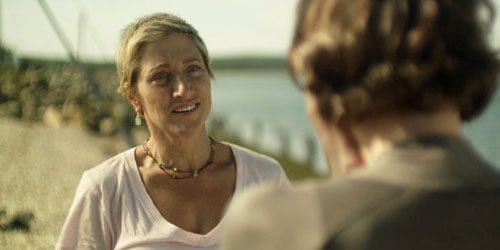
The suburbs are a critical space in American popular culture. The suburban population is in at least the tens of millions, but books, TV, and film are rife with disquieting and disturbed representations of these places. Malaise and alienation are the persistent themes in American arts and letters on suburban towns and neighborhoods. Particularly in addressing the traditional residential suburb, well kept yards, finely appointed houses, and nuclear families always mask dark personal secrets and social transgressions.
In 3 Backyards, writer-director Eric Mendelsohn (Judy Berlin, 1999) complicates these tropes by making a low-key, fragmentary drama about one day in the life of a cast of characters linked only by where they live. Set and shot on Long Island, New York, the film follows John (Elias Koteas), Peggy (Edie Falco), and Christina (Rachel Resheff) through their respective courses on the day.
John and Peggy are recognizable types. He is the emotionally withdrawn businessman, husband, and father, while she is the housewife who wiles her time away in “creative” pursuits, painting landscapes, and gossiping.
John spends his day waiting on a rescheduled plane flight and avoiding talking to his wife (Kathryn Erbe) about some unspecified problem. Peggy seeks to cultivate a friendship with her new neighbor, an actress (Embeth Davidtz), and spends her afternoon giving the other woman a ride to the ferry. In biding his time, John fixates on a young woman in a blue dress (Danai Gurira), whom he spies in different places looking for work and who may or may not be dead at film’s end after being hit by a van. Peggy ultimately fails at making a connection with the actress, overwhelming the other woman with her own neediness, instead.
Christina is the most unique of the three characters; she’s a dreamy school girl whose day starts with her stealing away with her mom’s birthday present, a bracelet, and missing the school bus. This forces her to walk to school, which she does with pleasure, happily cutting through open spaces and yards. Eventually, she stumbles into a backyard where she first encounters a poodle, which the audience already knows has been reported lost, and who Christina sets free. Then she encounters a man in a shed masturbating to a magazine. Not really understanding what she sees, Christina does notice a collection of dog collars in the shed and tries to tell the man that she found “his dog”, before running off and losing the bracelet in the yard.
Mendelsohn, with director of photography Kasper Tuxen and editor Morgan Faust, make visual connections between the characters through camera movement and zooms that draw figurative lines from one to another, and dissolves that move the stories forward in time and space. Narratively, all three remain separate.
The human dramas are also cinched together by musical interludes and images of nature that surround and enfold the houses, or “backyards”, of the residents, an effect also made by the persistence of certain sounds, such as the buzzing of insects. Michael Nicholas’ score fosters feelings that alternate between harmony and discord, both following and establishing the moods and rhythms of the day.
3 Backyards hints at the kinds of darkness that typically marks the field of suburban representation, but in favoring the quotidian and the individual, never becomes melodramatic or a deep excavation of its characters’ secrets. Viewers know that John and his wife are having problems, but not what they are. You also never learn what his intentions might be regarding the young woman with whom he keeps crossing paths.
Peggy ends the movie in a depressive state, but whether this is from the day’s events or from longer reaching issues, can only be inferred. The “Big Man” that Christina encounters suggests social and sexual dysfunction, but the two also share a weirdly sweet moment that opens the door to less dire interpretations of the man’s shed and its uses.
As much as I can admire what makes 3 Backyards different from more conventional suburban dramas, I’m also left with the feeling that there may be less to the film than the sum of its parts. There is an effective sense of simultaneity, of lives being led here and now, but the larger whole, the interconnections implied by the metaphoric mapping of the characters and images of a greater nature, never cohere in a meaningful way.
For all of its open-endedness and commitment to looking at the suburbs in a topographic way, to sticking to the surface, the film does not offer new insights into what it means that these characters share this place. While the sense of the place maybe more personal, more “real” in a material sense, than that imparted by more intensified representations such as American Beauty (1999) or The Ice Storm (1997), I am still left with the same feelings of ennui and alienation engendered by those other, “bigger” films.

![Call for Papers: All Things Reconsidered [MUSIC] May-August 2024](https://www.popmatters.com/wp-content/uploads/2024/04/all-things-reconsidered-call-music-may-2024-720x380.jpg)



